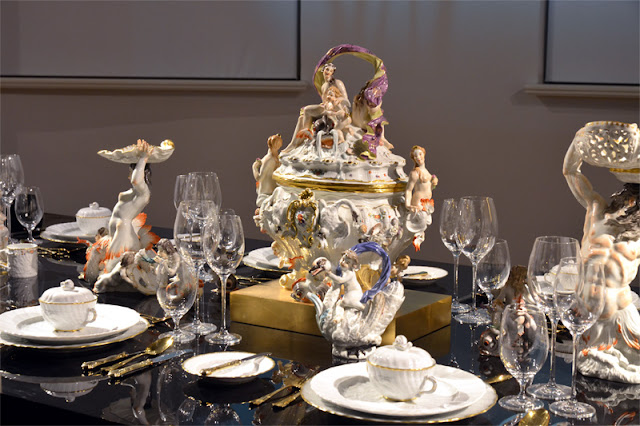Meissen porcelain is the first European hard-paste porcelain that was developed from 1708 by Ehrenfried Walther von Tschirnhaus. After his death that October, Johann Friedrich Böttger, continued his work and brought porcelain to the market. The production of porcelain at Meissen, near Dresden,
started in 1710 on the Albrechtsburg and attracted artists and artisans to establish one of
the most famous porcelain manufacturers, still in business today as Staatliche Porzellan-Manufaktur Meissen GmbH.
View from the Albrechtsburg on the river Elbe and the eastern part of Meissen.
*** *** *** *** ***
End of October we visited the Holy Grail of porcelain manufacturing in Germany:
The Staatliche Porzellan-Manufaktur Meissen GmbH
The headquarters in the town of Meissen, Saxony, is production plant, demonstration workshop, showroom, museum, sales outlet and flagship boutique all in one.
In four separate demonstration workshops visitors are guided through the main stages of porcelain production. So you will be able to witness the craftsmanship that goes into making Meissen Porcelain.
1. Relief-moulded cups are “thrown” and
parts of figurines moulded at the workbenches of a thrower and modeller.
2. A person known
as a repairer or fettler then joins the parts of a figure together. A finished
example stands before the visitors as a guide on how to proceed.
3. Underglaze
painting is demonstrated citing the example of Meissen’s famous Onion Pattern.
4. The
tour concludes with a display of overglaze painting. Floral decorations and
painting based on oriental motifs are used to illustrate this multifaceted
technique with its extensive nuances of colour.
*** *** *** *** ***
Ok, let's continue with a view to the Meissen artCAMPUS exhibition, on three current porcelain artworks of Chris Antemann, an US lady and artist...
*** *** *** *** ***
Some other masterpieces I was able (and allowed) to photograph in the museum...




























No wonder why Meissen is so teuer!
AntwortenLöschenWonderful work.
Cheers Uwe!
Márcia
Umsonst ist der Tod, und selbst der kostet das Leben, Márcia! :-)
AntwortenLöschenUwe.
Oh this is a delightful post! Thank you so much for sharing. Every piece from the Meissen artCAMPUS exhibition is stunningly beautiful. It sure took a lot of time to make them,
AntwortenLöschenThanks, Sapphire, for your warm words. In the demonstration workshop a group of Japanese visitors followed our German group. But obviously you was not among these travellers from Japan... ;-)
AntwortenLöschenEnjoy your weekend - the weather and temperatures at Tokyo is/are currently much more comfortable than the autumnal weather we have here in Germany at the moment.
Uwe.
Hi, Uwe! On my journey to Germany, I didn’t visit Meissen, but I purchased a Meissen’s tiny pendant top with the design of hand painted flower at a hotel shop. To my sadness, it was stolen together with other valuables when my house was broken into by a thief while I was away. Your photos show various dolls of modern design. Last year, I saw “hina dolls” made by Meissen. I like blue onion of Meissen and other floral patterns. Thanks for this post.
AntwortenLöschenYoko
What a pity...
AntwortenLöschen...but obviously your thief had a good education plus a delicate taste to take the fragile Meissen china as stolen goods.
I'm sure one day you'll get another Meissen masterpiece as a gift...
...perhaps your husband wonders what to give to you as a birthday or Christmas present???
There were a lot of China dolls in the Meissen museum, but I had to post a hundert photos just to show a small selection of the whole collection.
The Meissen manufacture made more than 200.000 differnt models over the last 300 years and all the molds are kept and preserved in their archive...
Have a pleasant weekend.
Uwe.